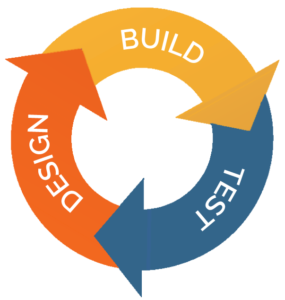Rapid Iterative Prototyping & MVP
Rapid iterative prototyping employs the techniques discussed above to create interactive representations of a product or service, often known as a minimum viable product (MVP) and then utilises phases of user research followed by design iteration to produce a robust, customer centric design, ready for development.
There are three stages to the rapid iterative design process that we provide and these are Design > Build > Test.
Prior to these the proposition will have been developed to the point where there is a tangible opportunity for design. The service we provide moves organisations from the developed concept to build stage by delivering a robust and fully evaluated high fidelity prototype.
The Design > Build > Test Cycle
The rapid iterative design process is fairly straight forward and is exactly as described.
– Design – We develop the design from the proposition
– Build – We turn the design into a prototype
– Test – We test the prototype with the users
This sequence is run over and over again until we have a fully working prototype of the proposition, product or service ready for build.
Again, our assumption is that the personas exist, that the proposition has been somewhat validated and that this is about execution. A typical cycle will take between 3 to 5 days and with each cycle the prototype fidelity tends to increase. To start with we may be testing very rough mock-ups and by the end be prototyping in Axure and have added look and feel, some copy and more.
Location
With fast cycle times we tend not to be user testing in a research facility and will often start with guerrilla testing in a café – assuming the proposition fits this type of audience. During the later cycles, we test in a meeting room with recruited participants and organise these weeks in advance and build toward these sessions.
We are able to stream the video from these sessions to the rest of the team and so all user research will be followed by a brainstorming session and action plan for the prototype iteration.
Documenting the Research
Although lean and agile UX calls for limited documentation we do keep records of the design decisions we have taken, the outcomes of the research and issues with the build. This documentation is at a high level but allows us to deliver the developed prototype to the client together with the evidence of how we arrived where we did. This documentation also allows us to provide incremental updates to the client as we go forward.
Agile Development Team
When we provide rapid iterative prototyping services we are typically doing so as a stand-alone project team. That means we are taking the brief from you and giving you back developed designs. After discussing the brief with you we will be able to provide you with a scope of work that is reasonably fixed.
If you would prefer us to work on a time and materials basis as part of your team we are happy to discuss this approach also.
Have a Project in Mind?



